ISSN
2307–3489 (Print), ІSSN
2307–6666
(Online)
Наука
та прогрес транспорту. Вісник
Дніпропетровського
національного університету залізничного
транспорту, 2018, № 4 (76)
рухомий
склад залізниць і тяга поїздів
UDC 629.4.02
M. I. KAPITSA1*,
o. M. HNENNYi2*,
d. V. BOBYR3*
1*Dep.
«Locomotives», Dnipropetrovsk National University of Railway
Transport named after Academician V. Lazaryan,
Lazaryan St., 2,
Dnipro, Ukraine, 49010, tel. +38 (0562) 33 19 61, e-mail
m.i.kapitca@ua.fm, ORCID 0000-0002-3800-2920
2*Dep.
«Economics and Management», Dnipropetrovsk National University of
Railway Transport named after Academician
V. Lazaryan, Lazaryan
St., 2, Dnipro, Ukraine, 49010, tel. +38 (056) 373 15 80, e-mail
oleggnennij@gmail.com,
ORCID 0000-0002-2944-5105
3*Dep.
«Locomotives», Dnipropetrovsk National University of Railway
Transport named after Academician V. Lazaryan,
Lazaryan St., 2,
Dnipro, Ukraine, 49010, tel. +38 (0562) 33 19 61, e-mail
dmitrob@ua.fm, 0000-0003-1441-3861
EFFICIENCY OF MODERNIZATION OF WHEEL-MOTOR BLOCKS
USING ANTI-FRICTION TRACTION MOTOR SUPPORT BEARINGS
Purpose. The use of anti-friction traction motor
support bearings (TMSB) instead of plain friction traction motor
support bearings is a priority direction of locomotive development
both for newly constructed locomotives and for those in operation.
The solution of the set tasks for introduction of wheel-motor blocks
(WMB) with anti-friction bearings demanded the search for alternative
variants and new technical solutions. The purpose of the article is
to determine the feasibility of re-equipping the diesel locomotive
wheel-motor blocks with anti-friction bearings through the life cycle
calculation (LCC). Methodology. The procedure and
criteria for assessing the economic efficiency of project
(investment) proposals and investment projects approved by the
Cabinet of Ministers of Ukraine envisage that the cost-effectiveness
analysis of an investment project is carried out according to the
following criteria: net present value, internal rate of return,
discounted payback period and profitability index. The use of these
criteria of economic efficiency fully corresponds to modern
principles, theoretical-methodical approaches and world practice in
evaluating the efficiency of investments. The evaluation of the
technical and economic efficiency of the modernization of the diesel
locomotive wheel-motor block is made on the basis of calculation and
comparison of the following criteria: the net present value (NPV)
of modernization, the internal rate of return (IRR), the
profitability index (PI) and the discount payback period.
Findings. The results of the calculations of the values of the
main criteria show that the innovative project for the modernization
of the locomotive provides a high level of economic efficiency. At
the same time, the value of the discounted payback period of
investments in modernization indicates that it is expedient to carry
out this operation if the residual life of the upgraded locomotive of
the M62 series is at least 15 months. Originality. Taking into
account the specifics of the type of locomotive work in freight
traffic, we developed a method to determine the individual components
of the average annual economic effect of modernization of the diesel
locomotive wheel-motor block, which includes saving of oil costs,
repairing and servicing the diesel locomotive wheel-motor unit, as
well as change of TMSB brass and saving fuel costs for traction.
Practical value. The results of the work make it possible
to determine the expediency of modernization of diesel locomotives
taking into account the features and conditions of their operation
and the specifics of modernization.
Keywords: diesel locomotive modernization;
wheel-motor block; technical and economic efficiency; anti-friction
bearings; life cycle
Introduction
The priority direction of the
investment policy of PJSC «Ukrzaliznytsia» in the locomotive
economy of Ukraine in recent years is to provide a quick,
comprehensive renovation and optimization of the traction rolling
stock structure. This is due to the fact that most of the traction
rolling stock was procured and delivered to operation even in Soviet
times. Analysis of the state of the operating fleet of the traction
rolling stock of Ukrainian railways indicates that its wear is 97.1%
[11]. As it is known, the results of rail transport activity in
general depend on the level of technical excellence and the state of
the traction rolling stock, conditions of its operation, repair and
maintenance systems [14, 15].
The traction
rolling stock may be renewed due to the purchase of a new one and
the modernization of the existing one. In both cases, this requires
significant capital investments. It is also necessary to take into
account that the return on investments in modernization of
locomotives is 3-4 times faster than in their acquisition.
Therefore, in the context of market relations and financial
constraints, the problem of investment support for the renewal of
the tractive rolling stock of the locomotive economy of Ukrainian
railways is put forward at the level of problems of national
importance, the solution of which directly affects the provision of
national security.
During the
last years, the Department of the Locomotive Economy has introduced
a number of steps for modernization of the traction rolling stock,
aimed at reducing the cost of repairs and fuel and lubricants in
operation. Directions of accomplished and planned modernizations
mainly concern the replacement of power equipment. However, no less
effective direction of modernization of the traction rolling stock
is the improvement of underframe design, namely the refitting of WMB
from plain friction bearings to anti-friction bearings [2].
Anti-friction bearings have
several advantages over plain friction bearings. The main advantage
of anti-friction bearings in comparison with plain friction bearings
is the lower energy consumption for the friction process (friction
moment in ball bearings is approximately 3-6 times less than that of
plain friction bearings [6, 12]).
All new
foreign locomotives are equipped with anti-friction TMSB. Their
implementation allows conducting the locomotive maintenance M-2 not
every 3-4 days, but every 10-12 or more. It is the replenishment of
the plain friction TMSB with axial oil that requires the need for
such frequent maintenance M-2 for 90% of the locomotive fleet [12].
Estimated resource of
anti-friction TMSB is not less than 5 million km of locomotive
mileage. Application of wheel-motor blocks with anti-friction TMSB
increases the cost of a locomotive, but payback is achieved due to
the presence of the following factors:
– Exclusion
from the technological process of servicing and repair of WMB of
axial oils and the necessity of their seasonal change;
– Cost
reduction for technical maintenance and repairs of the WMB with
anti-friction TMSB;
– Increase
of reliability and service life of traction gear and traction
electric motor (TEM) due to absence of distortion caused by wear of
brass inserts of plain friction traction motor support bearings;
– Increase
in the wheel set life cycle due to the lack of wear of the journals
under the plain friction TMSB;
– Absence
of the need to pay fines for environmental pollution by eliminating
the leakage of axial oils on the permanent way;
– Increase
in the locomotive profitability – increase in the use of power for
draft, increase in efficiency by reducing the main resistance of the
locomotive, and, accordingly, reducing fuel consumption for traction
from 2% to 6.6% [8, 12].
Thus, the use of anti-friction
TMSBs instead of plain friction TMSBs is a priority direction for
locomotive development for newly constructed locomotives and for
those in operation.
The solution of the set tasks
for introduction of WMB with anti-friction bearings demanded the
search for alternative variants and new technical solutions.
Therefore, the specialists of «Scientific and Technical Center
«Pryvod» LLC and PJSC «Scientific-Production Enterprise
«Smelyansky Electromechanical Plant» have been developed and
patented in the State Intellectual Property Service of Ukraine
(patent for utility model No. 84796 dated October 25, 2013) the
project for modernization of WMB locomotive with anti-friction TMSB
replacement.
Modernization of WMB consists
of two stages:
– Modernization
of traction electric motor with prolongation of service life for 15
years;
– Modernization
of wheel set and the gear casing (if required).
In accordance with the
technical specifications of TU U 30.2-38414897-004: 2014
«Modernization of wheel-motor blocks of locomotives including
replacement of plain friction TMSB with the anti-friction TMSB»,
modernization of the traction motor is carried out during its
overall repair. This includes the repair of the engine case, anchor
and magnetic system with replacement of windings and isolation of
the class of heat resistance not lower than «H», bearing units
with the restoration of their sizes to drawings and the execution
(if necessary) of improvements in accordance with the requirements
of design documentation for modernization. Conducting of
modernization can increase the TEM life for 15 years.
Purpose
The purpose of the article is
to determine the technical and economic efficiency of the
modernisation of locomotive WMB TMSB with anti-friction bearings
based on LCC calculations.
Methodology
At the present time in Ukraine
there are several normative documents in the field of
cost-effectiveness analysis of investments. The main ones are:
– Procedure
and Criteria for Assessing the Economic Efficiency of Project
(Investment) Proposals and Investment Projects, approved by the
Cabinet of Ministers of Ukraine as of 18.07.2012, No. 684;
– Methodological
Recommendations on Development of State Supported Investment
Projects, approved by Order of the Ministry of Economic Development
and Trade of Ukraine as of 13.11.2012, No. 1279;
– Methodological
Recommendations on Assessment of Economic and Social Efficiency of
State Target Program Implementation, approved by Order of the
Ministry of Economy of Ukraine as of 24.06.2010, No. 742;
– Methodology
of Conducting State Expertise of Investment Projects, approved by
Order of the Ministry of Economic Development and Trade of Ukraine
as of 13.03.2013, No. 243;
– Methodological
Recommendations on Development of Business Plan of Enterprises,
approved by Order of the Ministry of Economy of Ukraine as of
06.09.2006, No. 290;
– Methodology
for Determining the Cost-effectiveness of Research and Development
and their Implementation in Production, approved by Order of the
Ministry of Economy and European Integration and the Ministry of
Finance of Ukraine as of 26.09.2001, No. 218/446.
The Procedure and Criteria for
Assessing the Economic Efficiency of Project (Investment) Proposals
and Investment Projects, approved by the Cabinet of Ministers of
Ukraine as of 18.07.2012 No. 684 stipulate that the assessment of
the economic efficiency of an investment project is carried out
according to the following criteria: net present value, internal
rate of return, discounted payback period and profitability index.
Herewith, the conclusion is positive about the effectiveness of the
investment project, if the net present value is positive, the
internal rate of return is greater than the standard discount rate,
and the profitability index exceeds 1. The use of these criteria of
economic efficiency fully corresponds to modern principles,
theoretical and methodological approaches and world practice
regarding assessment of investment efficiency. However, the
mentioned document does not contain specific methodological
approaches, but suggests that the calculation of the criteria for
the economic efficiency of an investment proposal, an investment
project is carried out in the light of the Methodological
Recommendations on Development of State Supported Investment
Projects, approved by the Ministry of Economic Development and
Trade.
Methodological
Recommendations on Development of State Supported Investment
Projects, approved by Order of the Ministry of Economic Development
and Trade of Ukraine as of 13.11.2012, No.
1279 contains
(paragraph 2.8) the methodology for determining the above mentioned
investment efficiency indices. At the same time, the methodological
recommendations do not explain the issue of considering risks when
assessing the effectiveness of the project. It is intended to
provide in the project a separate section on information on project
risks, precautionary measures and risk insurance in cases stipulated
by law (paragraph 2.10). Herewith, only a qualitative characteristic
of risks is foreseen. That is, the above Methodological
Recommendations do not contain quantitative methods for assessing
investment risks and their accounting procedure when assessing the
cost-effectiveness of an investment project.
Methodological
Recommendations on Assessment of Economic and Social Efficiency of
State Target Program Implementation, approved by Order of the
Ministry of Economy of Ukraine as of 24.06.2010, No. 742, among
other things, contain an algorithm for calculating the four key
indices of economic efficiency, which coincides with the methods
presented in the above Methodical Recommendations on Development of
Investment Project. It also
proposes the
use of
several specific
indices for
innovative
projects: value
added, ratio
of investments
(private and
public),
commercialization
coefficient and
new product
sales
coefficient. In
addition, the Methodical recommendations under consideration include
methods for assessing the synergistic economic effect of program
interaction, which allow assessing the economic effectiveness of the
program as a system of interconnected projects, that is to move from
the assessment of individual investment projects to the assessment
of the effectiveness of their integrated implementation. The
synergistic effect of program interaction includes the effects of
program centralization, concentration, specialization, cooperation
and replication of intermediate and final results. The mentioned
Methodological Recommendations contain methodological approaches to
the determination of each of these effects. However, these
Methodological Recommendations do not also contain the
methodological approaches to risk assessment in determining the
cost-effectiveness of investment projects and programs.
Methodological Recommendations
on Development of Business Plan of Enterprises, approved by Order of
the Ministry of Economy of Ukraine as of 06.09.2006, No. 290 contain
methodological approaches for forecasting cash flows from the
activity of the enterprise and determination of economic investment
efficiency indices, which, in general, coincide with the
Methodological Recommendations on Development of Investment Project,
are more detailed. The Methodological Recommendations under
consideration also do not include approaches to quantitative
investment risk. However, based on the analysis of paragraph
2.1.10.3 of the Methodological Recommendations, one can conclude
that the main way of taking into account the risks in assessing the
economic efficiency of investments is to increase the discount rate
by the risk premium, since it is determined that «discount rate (r)
is the rate of profit, that investors usually receive from
investments of similar content and degree of risk».
Methodology
for Determining the Cost-effectiveness of Research and Development
and their Implementation in Production, approved by Order of the
Ministry of Economy and European Integration and the Ministry of
Finance of Ukraine as of 26.09.2001, No. 218/446 contains approaches
to the definition of key indices of economic efficiency of projects.
At the same time there are differences with the previously
considered normative acts in determining the «profitability index
«. So in these recommendations it is defined as the ratio of net
discounted income to the discounted investment value, and in all
other regulatory acts – as the ratio of the present value of the
results (net cash inflow) to the present value of investment outlay.
As the Procedure and Criteria for Assessing the Economic Efficiency
of Project (Investment) Proposals and Investment Projects, approved
by the Cabinet of Ministers of Ukraine as of 18.07.2012 No. 684
determines the efficiency criterion as the profitability index
higher than 1, more correct definition of this index is given in the
Methodological Recommendations on
Development of State Supported Investment Projects, approved by
Order of the Ministry of Economic Development and Trade of Ukraine
as of 13.11.2012, No. 1279. However, the Methodology for Determining
the Cost-effectiveness of Research and Development and their
Implementation in Production contains certain elements of
methodological approaches to risk assessment when measuring
efficiency. Thus, the paragraphs 3.20 and 3.21 of the Methodology
stipulate that mid-term and long-term R & D projects concerning
the timing of their implementation need to take into account the
uncertainty and risk factor. The following methods can be used to
take into account the uncertainty and risk factor: verification of
project sustainability, adjustment of project parameters, formal
description of uncertainty. The
project sustainability is determined by the break-even point.
Correction of project parameters is based on refinement of the
initial technical and economic task, including the terms of the
project due to delays in financing its stages, procedural violations
in the implementation of innovations, violation of terms of
feedstock supply and other complications. In all cases of such
violations the resulting losses are added to the project cost
structure. The paragraph 3.22 (formula 3.16) of the Methodology
stipulates the application of a capital asset valuation model to
determine the discount rate allowing for risk.
Thus, domestic regulatory acts
in the field of cost-effectiveness analysis of innovation and
investment projects reflect a certain methodical toolkit on the
structure of forecast cash flows, the definition of their
components, the calculation of the main indicators of economic
efficiency of investment, taking into account the factor of time,
which in general corresponds to the modern theoretical foundations
of cost-effectiveness analysis and project analysis [1, 3, 4, 7, 10,
13, 15].
A cost-effectiveness analysis
of an innovation and investment project is carried out at such
stages.
Determination of project
life cycle.
II.
Forecast of cash flows by the base project scenario.
III.
Quantitative assessment of the risk level of the project.
IV.
Determination of discount rates for the base investment project
scenario based on the rate of return and risk level.
V. Determination of indices of
effectiveness by the base scenario and discount rate allowing for
risk premium.
The net
present value of the innovation and investment project is determined
by the formula:
 , (1)
, (1)
where
 – net present
value;
– net present
value;
 – discount
rate;
– discount
rate;
 –
project life
cycle;
–
project life
cycle;
 – the result
(economic
effect) of
the project
in the
t-th
period;
– the result
(economic
effect) of
the project
in the
t-th
period;
 – investment costs of the project in
t-th
period.
– investment costs of the project in
t-th
period.
The
criterion for project efficiency is the positive value of NPV.
When forecasting the results
and costs of a project in this work we use the concept of base
(fixed for a certain date) prices. Therefore, in the project under
consideration, the forecasted economic effect varies little over the
years of the investment life cycle and can be taken at the average
annual level. Investment costs of the project arise only in the
beginning of the investment life cycle and equal to the locomotive
modernization cost. Therefore, the formula for determining the net
present value of a project can be presented as:
 , (2)
, (2)
where
 – annual
economic effect of locomotive modernization;
– annual
economic effect of locomotive modernization;
 – locomotive
modernization cost;
– locomotive
modernization cost;
 –
useful life
of the
locomotive.
–
useful life
of the
locomotive.
The project internal rate of
return is defined as the discount rate, according to which the net
present value of the project is zero. It is established by solving
the equation:
 , (3)
, (3)
where
 is
the
internal
rate
of
return.
is
the
internal
rate
of
return.
The project
effectiveness criterion is the excess of the internal rate of return
over the discount rate.
The project
profitability index (PI) is determined by the formula:
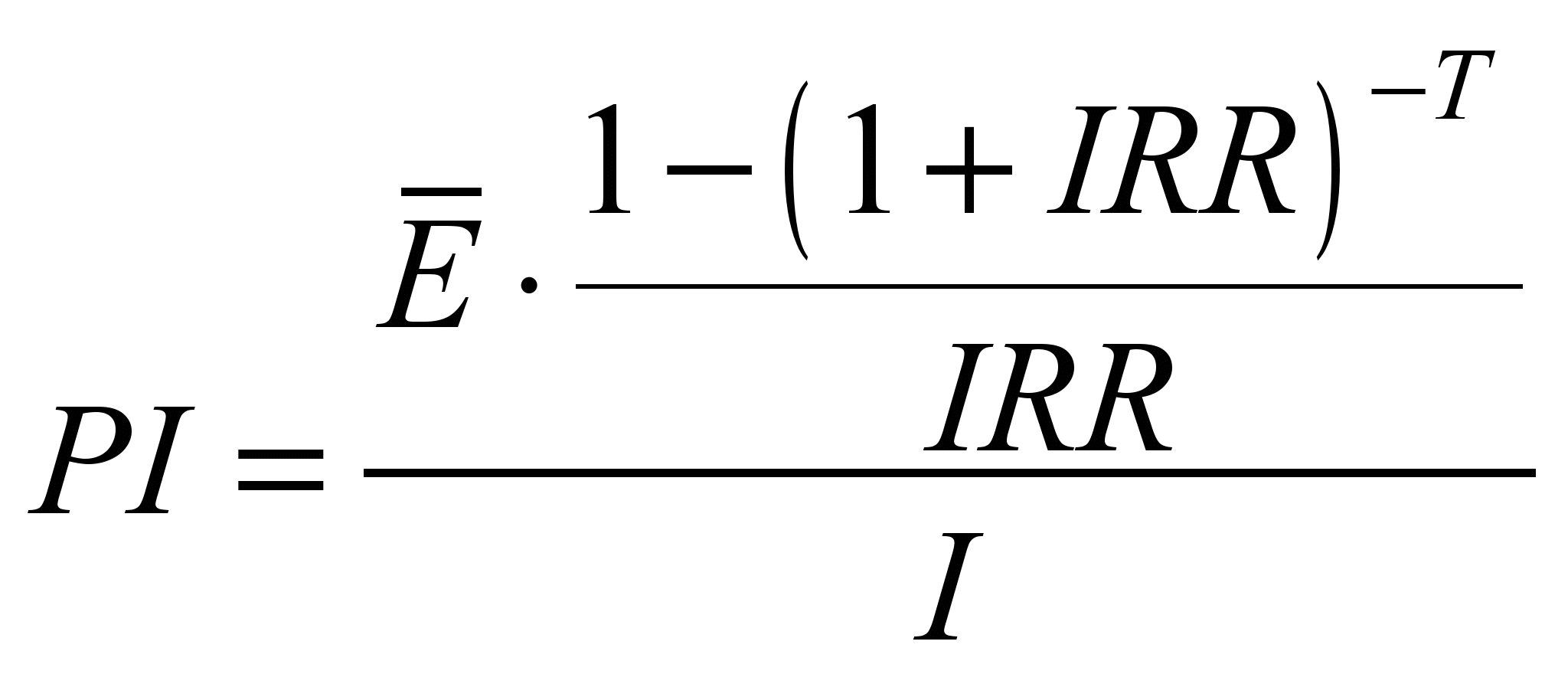 . (4)
. (4)
The project effectiveness
criterion is the value of the profitability index, which is greater
than or equal to one.
The discounted payback period
of the project investments is defined as the period from the start
of the life project cycle to the moment after which the accumulated
net present value of the portfolio becomes and continues to remain
positive. The effectiveness criterion is the magnitude of the
dynamic payback term, which is less than or equal to the duration of
the life portfolio cycle.
Under the
basic prices when forecasting cash flows we exclude the inflation
component from the composition of the discount rate by the formula:
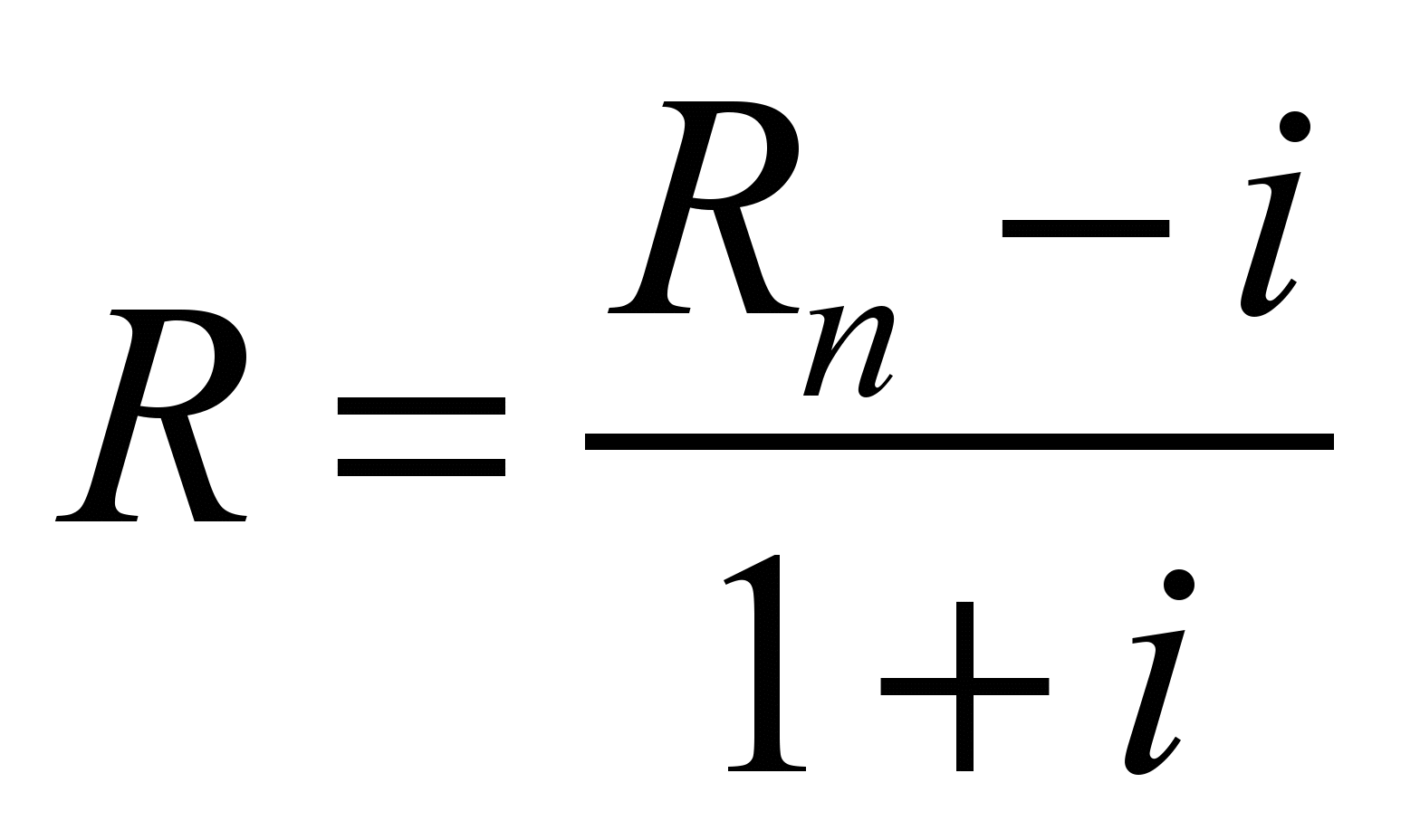 , (5)
, (5)
where
 – real
discount rate;
– real
discount rate;
 – nominal
rate discount;
– nominal
rate discount;
 – forecasted inflation rate.
– forecasted inflation rate.
The cost-effectiveness analysis
of locomotive modernization is carried out on the basis of
comparison of costs with the results arising from the modernization
during the life cycle of the locomotive.
The life cycle is taken equal
to the normative lifetime of the diesel locomotive. As investment
costs we considered the costs associated with the higher cost of the
wheel-motor block (WMB) with anti-friction TMSB in comparison with
the WMB with plain friction TMSB. The results are saving operating
costs, which are provided by the replacement of plain friction TMSB
with anti-friction TMSB. The mentioned costs are taken into account
in locomotive modernization cost.
The
average annual
economic effect
of locomotive
modernization
consists of
operating costs
saving
associated with
the locomotive
operation, and
includes:
– oil cost
savings;
– cost
savings for
repair and
maintenance of
diesel
locomotive
wheel-motor
blocks,
including the
change of
TMSB brass;
– fuel
consumption saving for hauling operations.
The oil cost savings are
determined based on the amount of oil changes and refilling to the
plain friction and anti-friction TMSB during repairs, the oil cost
for changes (refilling) during maintenance and the price of the oil
of the corresponding type.
The cost savings for repairing
and servicing diesel locomotive wheel-motor blocks are determined on
the basis of the complexity of the work involved, the tariff rates
of the workers and the cost of the brasses used for changes.
The fuel consumption saving for
hauling operations is determined on the basis of increasing the
coefficient of useful efficiency of gear transmission with
anti-friction TMSB, in comparison with plain friction TMSB.
The starting data for the
cost-effectiveness analysis of diesel locomotive modernization are
the operating norms of operation, maintenance and repair of
locomotives of a particular series, data of the developer of
modernization, statistical data of PJSC «Ukrzaliznytsia», State
Statistics Service of Ukraine, National Bank of Ukraine and results
of own researches of the executors of this work. Output data for
cost-effectiveness analysis of modernization of M62 diesel
locomotive are shown in Table 1, 2.
Table
1
Output
data for cost-effectiveness analysis, differing in variants
|
Index
|
Unit
of measure
|
Value
for the locomotive with
|
|
|
|
Plain
friction
TMSB
|
Information
source
|
Anti-friction
|
Information
source |
|
Oil
used in
TMSB
|
–
|
axial
oil of
«L», «Z»
grades (GOST
610-72)
|
data
of PJSC «UZ»
|
«Agrinol»
oil
|
data
of a developer
|
|
Frequency
of full oil filling of TMSB
|
–
|
during
repairs with
disassembly
of WMB,
in the
case of
brass
change,
during
seasonal oil
change
|
[4]
|
CR-3,
OR-1,
OR-2
|
data
of a developer
|
|
Frequency
of TMSB
oil
refilling
|
–
|
M-2,
M-3
|
[4]
|
CR-2
|
data
of a developer
|
|
Amount
of oil consumed when completely changed
|
l/lubr.
point
|
12
|
data
of PJSC «UZ»
|
1.5
|
data
of a developer
|
|
Amount
of oil
consumed
when
refilled
|
l/lubr.
point
|
0.4
|
data
of PJSC «UZ»
|
0.15
|
data
of a developer
|
|
Oil
price, ex
VAT
|
UAH/l
|
12.5
|
prozorro.gov.ua
|
51.82
|
data
of a developer
|
Table
2
Output
data for cost-effectiveness analysis, similar in variants
|
Index
|
Unit
of measure
|
Value
|
|
Number
of lubrication points
|
un./sect.
|
12
|
|
Normative
inter-repair periods:
|
|
|
|
–
maintenance M-2
|
hours
|
72
|
|
–
maintenance M-3
|
ths.
km
|
10
|
|
–
current repairs
CR-1
|
ths. km
|
50
|
|
–
current repairs
CR-2
|
ths. km
|
95
|
|
–
current repairs
CR-3
|
ths. km
|
195
|
|
–overall
repair OR-1
|
ths. km
|
780
|
|
–
overall repair
OR-2
|
ths. km
|
1 560
|
Continuation
of a table 2
|
Index
|
Unit
of measure
|
Value
|
|
Number
of lubrication points
|
un./sect.
|
12
|
|
Average
rate of
shed
percentage
of defective
diesel
locomotives
|
%
|
8
|
|
Normative
term of operation of diesel locomotive
|
years
|
20
|
|
Hourly
rate of
rolling
stock repair
mechanic,
taking into
account all
surcharges:
|
|
|
|
– 3-rd
category
|
UAH/year
|
33.47
|
|
– 5-th
category
|
UAH/year
|
42.92
|
|
The rate
of unified social tax
|
%
|
22
|
|
Average
cost of
the package
of TMSB
brasses, ex
VAT
|
UAH/TMSB
|
50 000
|
|
Actual
specific
consumption
of diesel
fuel in
freight
traffic for
M62 series
locomotive
|
kg/10 000
t-km
br.
|
34
|
|
Hourly
fuel
consumption
at idle
speed
|
kg/year
|
25
|
|
Average
weight of
freight
train with
M62
series locomotive
|
ton
|
3 781.82
|
|
Average
mileage of M62 series diesel locomotives
|
km
|
416
|
|
Cost
of diesel
fuel, ex
VAT
|
UAH/t
|
22 059
|
|
Increase
in the
efficiency
coefficient
of gear
with
anti-friction
TMSB, in
comparison
with plain
friction
TMSB
|
times
|
1.055
|
|
Cost
of
modernization
of the
wheel-motor
block under
anti-friction
TMSB, ex
VAT
|
ths.
UAH
|
357.6
|
|
Average
technical speed
|
km/year
|
45.6
|
Findings
To determine the flow of
lubricants to lubricate the TMSB, the number of repairs and
maintenance for the life cycle of the diesel locomotive is
determined in accordance with the repair cycle chart.
The assigned lifetime of the
locomotive mileage is defined as a double life of the run prior to
major repairs within OR-2, which is 3120 thousand km. Proceeding
from the mileage resource of the M62 series locomotive and the
standards of inter-repair runs, the normative quantity of repairs
and maintenance of the locomotive for a life cycle is determined,
which is:
– OR-2 – 1 repair;
– OR-1 – 2 repairs;
– CR-3 – 12 repairs;
– CR-2 – 17 repairs;
– CR-1 – 29 repairs;
– M-3 – 250 maintenances
per cycle;
– M-2 – 112 maintenances
per year.
When
performing the overall, current repairs, as well as maintenance for
the locomotives with plain friction TMSB, during a seasonal oil
change, its full replacement is carried out. In the course of
maintenance, the plain friction TMSBs are refilled with oil [5]. The
oil consumption for a complete change for the plain friction TMSB
is:
 l for the locomotive section, for oil refilling: 12·0.4 = 4.8 l for
the locomotive section. Thus, the average annual oil consumption for
plain friction TMSB reaches 1322.4 l.
l for the locomotive section, for oil refilling: 12·0.4 = 4.8 l for
the locomotive section. Thus, the average annual oil consumption for
plain friction TMSB reaches 1322.4 l.
When
performing the overall and current repairs for diesel locomotives
with anti-friction TMSB within CR-3, a complete change of oil is
carried out. When performing maintenance within M-2, the
anti-friction TMSBs are refilled with oil. The oil consumption for a
complete change for the anti-friction TMSB is: 12·1.5
= 18 l for the locomotive section, for oil
refilling: 12·0.15 = 1.8
l for the locomotive section. Thus, the average annual oil
consumption for the anti-friction
TMSB reaches 15.93 litres.
Taking into
account the loss of oil when pouring and refilling (10%), the
average annual cost of lubricants is:
– for locomotive with plain
friction TMSB – 18183 UAH;
– for locomotive with
anti-friction TMSB – 908 UAH.
The
cost savings
for lubricants
are: UAH per
year.
UAH per
year.
Costs
for maintenance
and repair
of M62
locomotive WMB
with plain
friction and
anti-friction
TMSB include
the costs
associated with:
– remuneration of employees
engaged in the maintenance and repair of WMB, the level of which is
determined by the complexity and skill of repair personnel;
– cost of materials and spare
parts for maintenance and repairs.
Labor costs are determined on
the basis of the list of TMSB-related works performed during
maintenance and repairs, the normative level of work and the value
of the standard hour of the respective category. It takes into
account the time factor for support needs 1.093 (for preparatory and
final actions 3.5%, time for servicing the workplace 3.1%, time for
rest and personal needs 2.7%, total – 9.3%).
The labor intensity of the
anti-friction TMSB maintenance is adopted at the level of 25% of the
corresponding value for the plain friction TMSB due to
simplification of the process of servicing the anti-friction TMSB.
The costs associated with
remuneration are given in Table. 3
Table 3
shows that the average annual labor costs are: for the plain
friction TMSB
 UAH, for the anti-friction TMSB
UAH, for the anti-friction TMSB
 UAH. Thus, the cost savings associated with remuneration are
UAH. Thus, the cost savings associated with remuneration are
 UAH per year.
UAH per year.
During the lifecycle of the M62
series locomotive, when performing overhaul repair, a complete
change of the TMSB brasses is performed. During CR-3 current repairs
35% of brasses are changed. The cost of the package of TMSB brasses
is 50 thousand UAH ex VAT. Thus, the average annual cost savings for
spare parts is:


In
the middle
conditions of
operation, the
M62 series
diesel
locomotive
(incl. the
idle time
in repairs)
per year
carries out
gross turnover
in the
amount of:
Table
3
Calculation
of expenses connected with remuneration of labour for work with TMSB
during
repairs and maintenance of M62 series diesel locomotive
during the life cycle
|
Type
of repair, maintenance
|
Class
of work
|
Hourly
rate, UAH
|
Labour
intensity with allowance for auxiliary time, man-hour
|
Number
of maintenances, repairs
|
Non-worked
time rate
|
Payroll
fund, UAH
|
Unified
social tax, UAH
|
Total
expenses, UAH
|
|
|
|
|
Plain friction
|
Anti-friction
|
|
|
Plain friction
|
Anti-friction
|
Plain friction
|
Anti-friction
|
Plain friction
|
Anti-friction
|
|
M-2
|
3
|
33.47
|
0.38
|
0
|
2240
|
1.1
|
31 339
|
0
|
6 895
|
0
|
38 234
|
0
|
|
M-3
|
5
|
42.92
|
4.59
|
0
|
250
|
1.1
|
54 176
|
0
|
11 919
|
0
|
66 095
|
0
|
|
CR-1
|
5
|
42.92
|
12.1
|
3.03
|
29
|
1.1
|
16 567
|
4 149
|
3 645
|
913
|
20 212
|
5 062
|
|
CR-2
|
5
|
42.92
|
16.26
|
4.07
|
17
|
1.1
|
13 050
|
3 267
|
2 871
|
719
|
15 921
|
3 986
|
|
CR-3
|
5
|
42.92
|
38.13
|
9.53
|
12
|
1.1
|
21 602
|
5 399
|
4 752
|
1 188
|
26 354
|
6 587
|
|
OR
|
5
|
42.92
|
87.44
|
21.86
|
3
|
1.1
|
12 385
|
3 096
|
2 725
|
681
|
15 110
|
3 777
|
|
Total
per life cycle
|
149 119
|
15 911
|
32 807
|
3 501
|
181 926
|
19 412
|


Specific fuel consumption is 34
kg per 10000 ton-km br. Total fuel consumption per year reaches
 tons.
tons.
Average
section speed
reaches 45.6 km/h,
then time in
the movement of
the diesel
locomotive of
the operating
rolling stock is
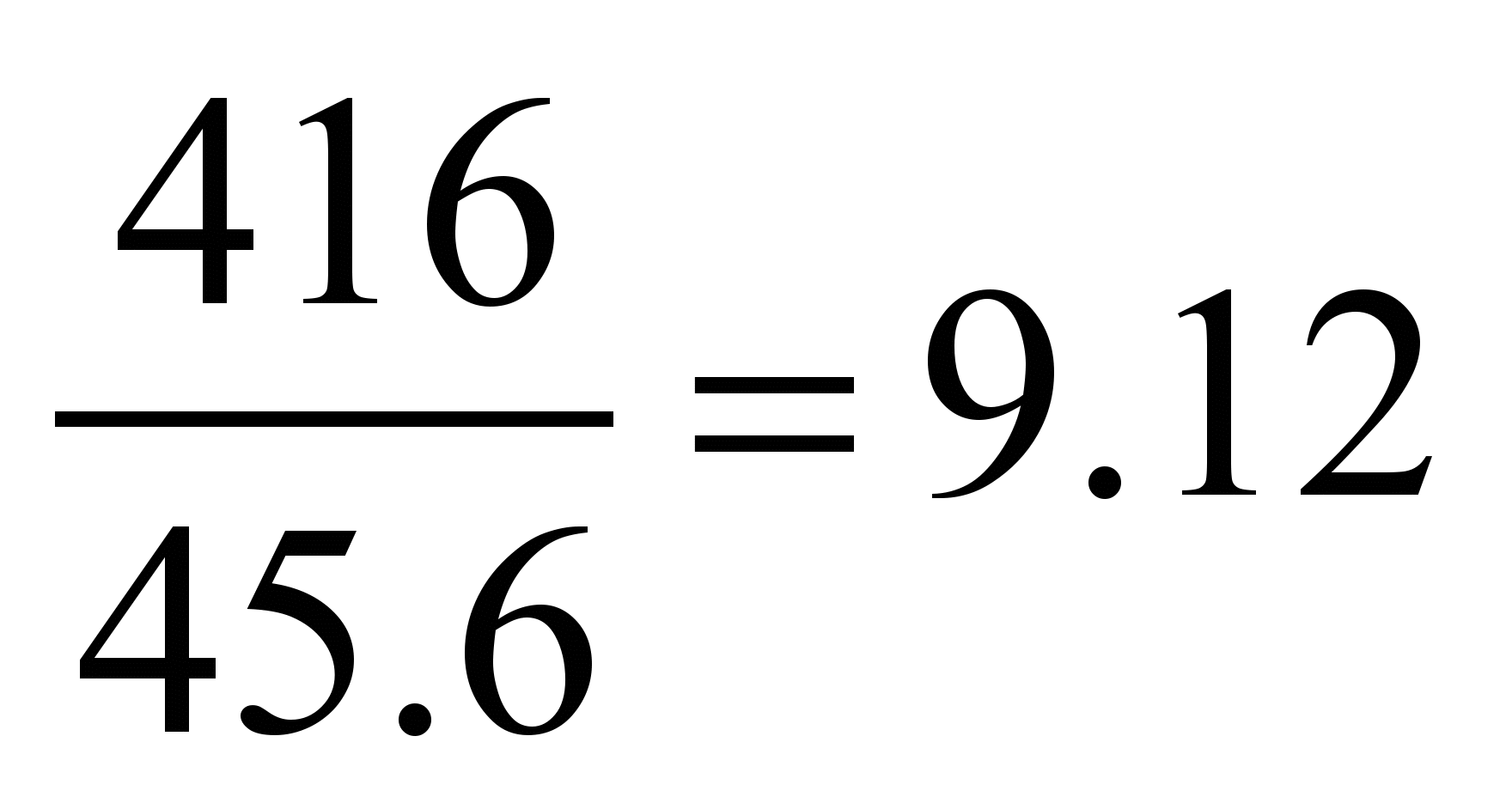 hours per day.
hours per day.
The annual budget of idle time
in «hot» condition of the M62 series locomotive reaches:
 hours per
year.
hours per
year.
Fuel
consumption for idle time in «hot»
condition reaches:
 tons.
tons.
Fuel consumption of the M62
series locomotive in the train operation reaches:
 tons.
tons.
Since
the gear
ratio efficiency
of the
anti-friction
TMSB is
1.055 times
higher than
that of
the plain
friction TMSB, fuel
savings will
average over
the year
 tons.
tons.
At
the cost
of diesel
fuel of
22059 UAH/ton,
the annual
saving in
fuel consumption
for hauling
operation will
be:
 UAH per year.
UAH per year.
The
overall average
annual economic
effect of
modernizing the
section of
the M62
series
locomotive
reaches:


Investment
costs per
M62 series
locomotive
section are
defined as
the product
of the
number of
WMBs and
the cost
of upgrading
one WMB
and equal
to:
 ths. UAH ex VAT.
ths. UAH ex VAT.
The
discount rate
is determined
using the
model of
capital asset
valuation
(-method)
as the
cost of
capital invested
in the
field of
economic
activity
«Transport».
The risk
factor
is defined as the ratio of the covariance
of the return of the investigated investment asset and the capital
market return.
As a measure of return on
investment, the profitability of equity capital of large and
medium-sized enterprises in Ukraine as a whole (capital market
return ratio) and the sphere of economic activity of «Transport»
(investment assets return ratio) are used. The net profit and equity
figures are shown in the Table 4 [9].
According
to Table 4, the
covariance of
profitability (55.7) and
market profitability
dispersion (155.4) were
determined. Thus, the
Betta coefficient for investments in the sphere of economic activity
«Transport» reaches

As the base rate, we used the
rate of return on investments with a minimum risk – the average
interest rate on long-term deposits of economic entities in 2017 was
14.3%.
The yield of the stock market
at the current time is defined as the average yield of the stock
index UX (index of Ukrainian shares) per one year (from 15.11.2016
to 15.11.2017). The index at period beginning was 791.11, at period
end – 1261.62 [9]. The average annual rate of income is

Thus, the nominal discount rate
before taxation is


Table 4
Determination
of the return on equity
|
Year
|
Net
financial result, mln. UAH
|
Average
equity, mln. UAH
|
Equity
at period end, mln. UAH
|
Return
on equity, %
|
|
|
in
Ukraine
|
transport
|
in
Ukraine
|
transport
|
in
Ukraine
|
transport
|
in
Ukraine
|
transport |
|
2016
|
13 324,4
|
6 622,533
|
1 790 507
|
727 082,3
|
1 806 908,5
|
729 340,6
|
0,74
|
0,91
|
|
2015
|
-373 516
|
-17 847,8
|
1 627 381
|
438 080,6
|
1 774 104,6
|
724 823,9
|
-22,95
|
-4,07
|
|
2014
|
-590 067
|
-22 591,6
|
1 715 516
|
165 346,2
|
1 480 658
|
151 337,3
|
-34,4
|
-13,66
|
|
2013
|
-22 839,7
|
-1 423,4
|
1 927 658
|
176 269,8
|
1 950 374,9
|
179 355,1
|
-1,18
|
-0,81
|
|
2012
|
35 067,3
|
3 127,7
|
1 745 612
|
179 525,3
|
1 904 940,2
|
173 184,5
|
2,01
|
1,74
|
|
2011
|
67 797,9
|
2 839,8
|
1 506 498
|
180 235,4
|
1 586 284,7
|
185 866
|
4,5
|
1,58
|
|
2010
|
13 906,1
|
1 348,7
|
1 348 125
|
169 027,3
|
1 426 711,6
|
174 604,7
|
1,03
|
0,8
|
|
2009
|
-37 131,1
|
4 889,5
|
1 201 571
|
155 846,4
|
1 269 537,7
|
163 449,8
|
-3,09
|
3,14
|
|
2008
|
-41 025,1
|
234,5
|
1 081 690
|
139 033,1
|
1 133 603,7
|
148 242,9
|
-3,79
|
0,17
|
|
2007
|
–
|
–
|
–
|
–
|
1 029 775,5
|
129 823,2
|
–
|
–
|
When forecasting the costs, the
concept of base prices is used, so the real discount rate is used
for discounting. The inflation rate is assumed to be 11% per year
[9]. That is, the real discount rate reaches:
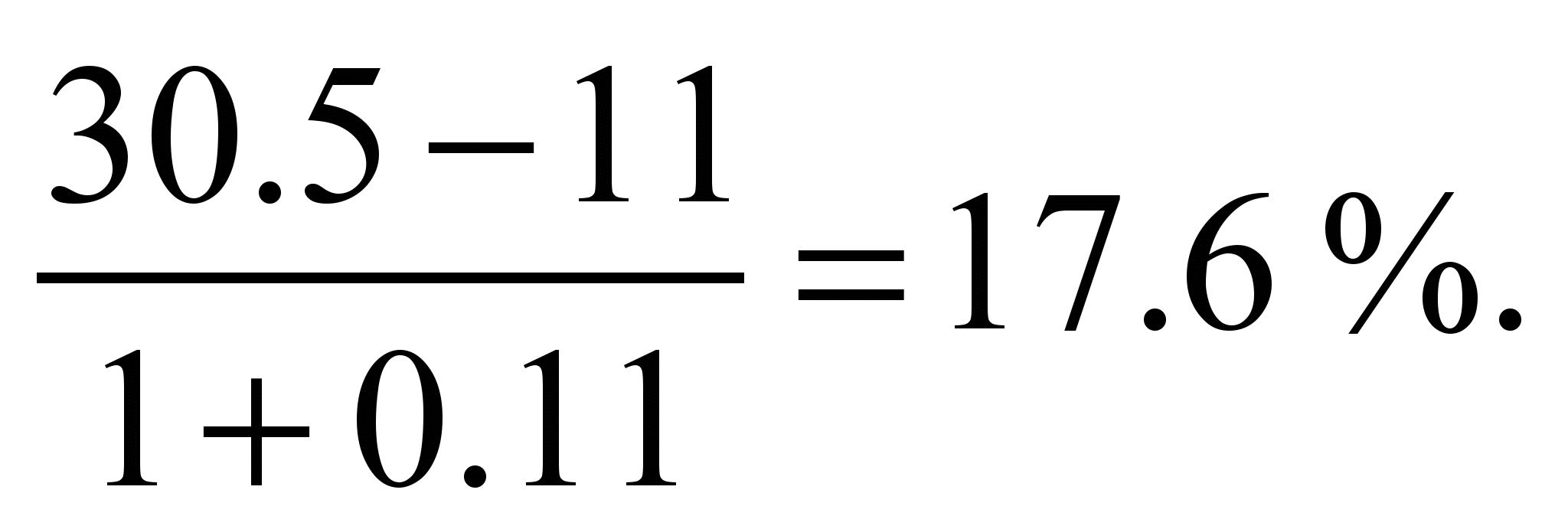
Thus,
the
main
indices
of
the
economic
efficiency
of
modernization
of
the
M62series
locomotive
are
as follows:




 times;
times;
 months.
months.
The graph of accumulation of
the net present value of the project is shown in Fig. 1
Originality and practical value
Taking into account the
specifics of the type of locomotive work in freight traffic, we
developed a method to determine the individual components of the
average annual economic effect of modernization of the diesel
locomotive WMB, which includes saving of oil costs, repairing and
servicing the diesel locomotive WMB, as well as change of TVSB brass
and saving fuel costs for traction.
The practical value of the work
lies in the fact that on the basis of the above methodology and
research results it is possible to determine the expediency of
modernizing the locomotive taking into account the peculiarities of
its operation.
Conclusions
It is clear
from the calculations above that the net present value (NPV)
of the project is 9662 thousand UAH, the internal rate of return
(IRR) of
the project is 100.7%, which exceeds the discount rate, the
profitability index (PI)
of the project is 5.5 times higher than 1. Schedule in Fig. 1 shows
that the discount payback period of the project is 1.2 years (14.4
months), which is considerably less than the life cycle of
investments.
Thus, the main criteria testify
that the considered innovative project on modernization of M62
series locomotive provides a high level of cost effectiveness.
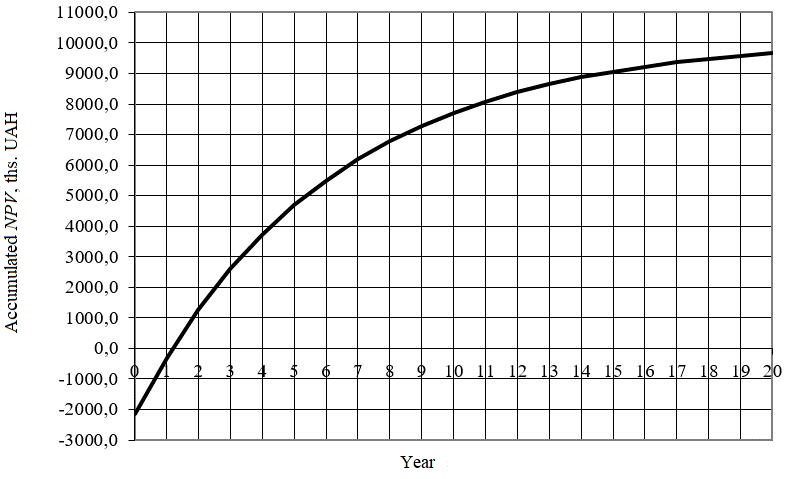
Fig.
1. Accumulation of net present value
At the same time, the value of
the discounted investment payback period for modernization shows
that it is expedient to conduct it if the remaining useful lifetime
of the modernization object (M62 series diesel locomotive) is not
less than 15 months.
The feasibility study is
executed in the prices and standards of 2017 at the stage of
development of the technical documentation for WMB modernization and
should be clarified according to the results of their work in real
operating conditions.
LIST OF REFERENCE LINKS
Бланк,
І. О. Інвестиційний менеджмент : підручник
/ І. О. Бланк. – Київ : Лібра, 2006. – 552 с.
Боднар,
Б. Є. Теорія та конструкція локомотивів.
Екіпажна частина : підручник / Б. Є.
Боднар, Є. Г. Нечаєв, Д. В.
Бобир. – Дніпропетровськ : Ліра ЛТД,
2009. – 284 с.
Дука,
А. I. Теорія та практика інвестиційної
діяльності. Інвестування / А. І. Дука.
– Київ : Каравела, 2008. – 432 с.
Гненний,
О. М. До питання оцінки та застосування
вартості життєвого циклу продукції
машинобудування / О. М. Гненний, А.
Мохаммадреза // Проблеми економіки
транспорту : зб. наук. пр. Дніпропетр.
нац. ун-ту залізн. трансп. ім. акад. В.
Лазаряна. – Дніпропетровськ, 2016. –
Вип. 12. – С. 7–12. doi:
10.15802/pte.v0i12.95609
Ендовицкий,
Д. А. Практикум по финансово-инвестиционному
анализу. Ситуации. Методики. Решения
: учеб. пособие / Д. А.
Ендовицкий, Л. С. Коробейникова, С. Н.
Коменденко ; под ред. Д. А. Ендовицкого.
– Москва : КноРус, 2006. – 432 с.
Інструкція
з використання мастильних матеріалів
на тяговому рухомому складі залізниць
України : ЦТ-0060 : затв. наказом Укрзалізниці
від 21.04.2003 р. / М-во трансп. України.
Держадміністрація залізн. трансп.
України. Голов. управ. колійного госп-ва.
– Київ : Девалта, 2003. – 55 с.
Лапицкий,
В. Н. Новый этап в эксплуатации
локомотивов: переход на моторно-осевые
подшипники качения [Electronic
resource] / В.
Н. Лапицкий, А. Г. Пашнин // Информио. –
2015. – Available
at:
http://www.informio.ru/publications/id1894/Novyi-yetap-v-yekspluatacii-lokomotivov-perehod-na-motorno-osevye-podshipniki-kachenija
– Title from
the screen.
– Accessed :
02.04.2018.
Методы
экономической оценки инвестиционных
проектов на транспорте : учеб.-метод.
пособие / Сост. Ю. Ф. Кулаев. – Киев
: Транспорт Украины, 2001. –
182 с.
МОП
качения на тепловозе ТЭМ18ДМ прошли
проверку временем [Electronic
resource] //
и-Маш. – 2013. – Available
at: http://www.i-mash.ru/news/nov_otrasl/32708-mop-kachenija-na-teplovoze-tjem18dm-proshli.html
chenija-na-teplovoze-tjem18dm-proshli.html
– Title from
the screen.
– Accessed :
02.04.2018.
Офіційний
сайт Державної служби статистики
України [Electronic
resource]. –
Available at:
– Title from
the screen.
– Accessed :
02.04.2018.
Проект
Програми Прогнозної оновлення рухомого
складу ПАТ «Укрзалізниця» на період
до 2021 року (станом на 21.11.2016). – Київ :
Укрзалізниця, 2016. – 16 с.
Тарута,
Д. В. Повышение долговечности
моторно-осевых подшипников тягового
электродвигателя тепловоза : дис. ...
канд. техн. наук : 05.22.07 / Дмитрий Викторович
Тарута ; Омский
гос. ун-т путей сообщения. – Омск, 2005.
– 178 с.
A
method to measure the eco-efficiency of diesel locomotive / B. B.
Carvalhaes,
R. A. Rosa, M. A. D’Agosto, G. M. Ribeiro // Transportation
Research.
Part D: Transport and Environment. –
2017. – Vol.
51. – P.
29–42.
doi:
10.1016/j.trd.2016.11.031
Bodnar,
B. Improving
Operation and
Maintenance of
Locomotives of
Ukrainian
Railways / B.
Bodnar, A.
Ochkasov, D.
Bobyr //
Technologijos ir Menas = Technology and
Art. – 2016.
– № 7. –
P. 109–114.
Shelley,
S. Evaluating attitudes to safety leadership within rail
construction projects /
S. Shelley,
B. Ryan, D.
Golightly // Safety
Science. – 2018. doi:
10.1016/j.ssci.2017.12.030
М. І. Капіца1*,
О. М. Гненний2*,
Д. В. Бобир3*
1*Каф.
«Локомотиви», Дніпропетровський
національний університет залізничного
транспорту імені академіка
В. Лазаряна, вул. Лазаряна, 2, Дніпро,
Україна, 49010, тел. +38 (0562) 33 19 61,
ел. пошта
m.i.kapitca@ua.fm,ORCID 0000-0002-3800-2920
2*Каф.
«Економіка та менеджмент», Дніпропетровський
національний університет залізничного
транспорту імені академіка В. Лазаряна,
вул. Лазаряна, 2, Дніпро, Україна, 49010,
тел. +38 (056) 373 15 80,
ел. пошта oleggnennij@gmail.com,
ORCID 0000-0002-2944-5105
3*Каф. «Локомотиви»,
Дніпропетровський національний
університет залізничного транспорту
імені академіка В.
Лазаряна, вул. Лазаряна, 2, Дніпро,
Україна, 49010, тел. +38 (0562) 33 19 61,
ел. пошта
dmitrob@ua.fm, ORCID 0000-0003-1441-3861
ЕФЕКТИВНІСТЬ
МОДЕРНІЗАЦІЇ КОЛІСНО-МОТОРНИХ БЛОКІВ
ТЕПЛОВОЗА З ВИКОРИСТАННЯМ МОТОРНО-ОСЬОВИХ
ПІДШИПНИКІВ КОЧЕННЯ
Мета. Використання
моторно-осьових підшипників (МОП)
кочення замість моторно-осьових
підшипників ковзання є пріоритетним
напрямком розвитку локомотивобудування
й експлуатації наявних локомотивів.
Вирішення завдань щодо впровадження
на локомотивах колісно-моторних блоків
(КМБ) із підшипниками кочення потребує
пошуку альтернативних варіантів і
нових технічних рішень. Метою статті
є визначення доцільності переобладнання
колісно-моторного блока тепловоза на
підшипники кочення шляхом розрахунку
життєвого циклу (LCC). Методика.
Порядок і критерії оцінки економічної
ефективності проектних (інвестиційних)
пропозицій та інвестиційних проектів,
затверджені постановою Кабінету
Міністрів України, передбачають, що
оцінку економічної ефективності
інвестиційного проекту здійснюють за
такими критеріями: чиста приведена
вартість, внутрішня норма дохідності,
дисконтований період окупності й індекс
прибутковості. Використання зазначених
критеріїв економічної ефективності
повністю відповідає сучасним принципам,
теоретико-методичним підходам і світовій
практиці оцінки ефективності інвестицій.
У роботі оцінка техніко-економічної
ефективності модернізації колісно-моторного
блока тепловоза проведена на основі
розрахунку й порівняння наступних
критеріїв – чистої приведеної вартості
(NPV) модернізації, внутрішньої норми
доходу (IRR), індексу дохідності (PI)
й дисконтного терміну окупності.
Результати. Виконані розрахунки
значень основних критеріїв свідчать,
що інноваційній проект із модернізації
тепловоза забезпечує високий рівень
економічної ефективності. При цьому
величина дисконтованого терміну
окупності інвестицій у модернізацію
передбачає, що її проведення є доцільним,
якщо залишковий ресурс строку корисного
використання модернізованого тепловоза
серії М62 не менший за 15 місяців. Наукова
новизна. З урахуванням особливостей
виду роботи тепловоза під час руху в
складі вантажного поїзда розроблена
методика з визначення окремих складових
середньорічного економічного ефекту
від модернізації колісно-моторного
блока тепловоза. До них
належать економія витрат на мастило,
на ремонт й обслуговування колісно-моторного
блока тепловоза, у тому числі заміну
вкладишів МОП, та економія витрат на
пальне для тяги поїздів. Практична
значимість. Результати
роботи дозволяють визначити доцільність
модернізації тепловозів з урахуванням
особливостей та умов їх роботи, а також
специфіки модернізації.
Ключові слова: модернізація
тепловоза; колісно-моторний блок;
техніко-економічна ефективність;
підшипники кочення; життєвий цикл
М. И. КапИца1*,
О. Н. ГненнЫй2*,
Д. В. Бобырь3*
1*Каф.
«Локомотивы», Днепропетровский
национальный университет железнодорожного
транспорта имени академика В. Лазаряна,
ул. Лазаряна, 2, Днипро, Украина, 49010, тел.
+38 (0562) 33 19 61,
эл. почта m.i.kapitca@ua.fm, ORCID
0000-0002-3800-2920
2*Каф. «Экономика и
менеджмент», Днепропетровский
национальный университет железнодорожного
транспорта имени академика В. Лазаряна,
ул. Лазаряна, 2, Днипро, Украина, 49010, тел.
+38 (056) 373 15 80,
эл. почта oleggnennij@gmail.com,
ORCID 0000-0002-2944-5105
3*Каф. «Локомотивы»,
Днепропетровский национальный
университет железнодорожного транспорта
имени академика В. Лазаряна, ул.
Лазаряна, 2, Днипро, Украина, 49010, тел.
+38 (0562) 33 19 61,
эл. почта dmitrob@ua.fm, ORCID
0000-0003-1441-3861
ЭФФЕКТИВНОСТЬ МОДЕРНИЗАЦИИ
КОЛЕСНО-МОТОРНЫХ БЛОКОВ ТЕПЛОВОЗА С
ПРИМЕНЕНИЕМ МОТОРНО-ОСЕВЫХ
ПОДШИПНИКОВ КАЧЕНИЯ
Цель. Использование
моторно-осевых подшипников (МОП) качения
вместо моторно-осевых подшипников
скольжения является приоритетным
направлением развития локомотивостроения
и эксплуатации имеющихся локомотивов.
Решение задач по внедрению на
локомотивах колесно-моторных блоков
(КМБ) с подшипниками качения требует
поиска альтернативных вариантов и
новых технических решений. Целью статьи
является определение целесообразности
переоборудования колесно-моторного
блока тепловоза на подшипники качения
путем расчета жизненного цикла (LCC).
Методика. Порядок и
критерии оценки экономической
эффективности проектных (инвестиционных)
предложений и инвестиционных проектов,
утвержденные постановлением Кабинета
Министров Украины, предполагают, что
оценка экономической эффективности
инвестиционного проекта осуществляется
по следующим критериям: чистая приведенная
стоимость, внутренняя норма доходности,
дисконтированный период окупаемости
и индекс доходности. Использование
указанных критериев экономической
эффективности полностью соответствует
современным принципам, теоретико-методическим
подходам и мировой практике оценки
эффективности инвестиций. В работе
оценка технико-экономической эффективности
модернизации колесно-моторного блока
тепловоза проведена на основе расчета
и сравнения следующих критериев –
чистой приведенной стоимости (NPV)
модернизации, внутренней нормы дохода
(IRR), индекса доходности (PI) и дисконтного
срока окупаемости. Результаты.
Выполненные расчеты значений основных
критериев свидетельствуют, что
инновационной проект по модернизации
тепловоза обеспечивает высокий уровень
экономической эффективности. При
этом величина дисконтированного срока
окупаемости инвестиций в модернизацию
предусматривает, что ее проведение
целесообразно, если остаточный ресурс
срока полезного использования
модернизированного тепловоза серии
М62 не менее 15 месяцев. Научная
новизна. С учетом
особенностей вида работы тепловоза во
время движения в составе грузового
поезда разработана методика по
определению отдельных составляющих
среднегодового экономического эффекта
от модернизации колесно-моторного
блока тепловоза. К ним относятся экономия
расходов на смазку, на ремонт и
обслуживание колесно-моторного блока
тепловоза, в том числе замену вкладышей
МОТ, и экономия затрат на топливо для
тяги поездов. Практическая значимость.
Результаты работы позволяют определить
целесообразность модернизации тепловозов
с учетом особенностей и условий их
работы, а также специфики модернизации.
Ключевые слова:
модернизация тепловоза;
колесно-моторный блок;
технико-экономическая эффективность;
подшипники качения;
жизненный цикл
REFERENCES
Blank,
І. O. (2006). Investytsiinyi
menedzhment : pidruchnyk. Kуіv:
Lіbra. (in
Ukranian)
Bodnar,
B. Y.,
Nechaiev, Y.
G., & Bobyr,
D. V. (2009). Teoriia ta konstruktsiia
lokomotyviv. Ekipazhna chastyna: pidruchnyk.
Dnіpropetrovsk: Lіra LTD. (in
Ukranian)
Duka,
A. I. (2008). Teoriia ta praktyka
investytsiinoi diialnosti. Investuvannia.
Kуіv: Karavella. (in
Ukranian)
Hnennyj,
O., & Mohammadreza, A. (2016). To the
question of evaluation and use of life cycle cost of engineering
product. Problemi
ekonomiki
transportu: zbirnik
naukovih
prac’
Dnipropetrovs’kogo
nacional’nogo
universitetu
zaliznicnogo
transportu imeni akademika V. Lazarana,
12, 7-12. doi:
10.15802/pte.v0i12.95609 (in
Ukranian)
Yendovitskiy,
D. A., Korobeinykova, L. S., &. Komendenko, S. N.
(2006). Praktikum po
finansovo-investitsionnomu analizu. Situatsii. Metodiki. Resheniya:
uchebnoe
posobie. Moscow:
KnoRus. (in
Russian)
Instruktsiia
z vykorystannia mastylnykh materialiv na tiahovomu rukhomomu skladi
zaliznyts Ukrainy: TsT-0060. (2003).
Kyiv: Devalta Ltd. (in
Ukranian)
Lapitskiy,
V. N., & Pashnin, A. G. (2015). Novyy etap v ekspluatatsii
lokomotivov: perekhod na motorno-osevye podshipniki kacheniya.
Informio.
Retrieved from
http://www.informio.ru/publications/id1894/Novyi-yetap-v-yekspluatacii-lokomotivov-perehod-na-motorno-osevye-podshipniki-kachenija
(in
Ukranian)
Kulaev,
Y. F. (2001).
Metody ekonomicheskoy otsenki
investitsionnykh proektov na transporte. Uchebno-metodicheskoe
posobie.
Kуіv: Transport Ukrainy. (in
Russian)
MOP
kacheniya na teplovoze TEM18DM proshli proverku vremenem.
(2013). i-Mash.
Retrieved from
http://www.i-mash.ru/news/nov_otrasl/32708-mop-kachenija-na-teplovoze-tjem18dm-proshli.html
(in Russian)
Ofitsiinyi
sait Derzhavnoi sluzhby statystyky Ukrainy. (2018).
Retrieved from http://www.ukrstat.gov.ua/operativ/menu/menu_u/sze.htm
Proekt
Prohramy
Prohnoznoi
onovlennia
rukhomoho
skladu
PAT
«Ukrzaliznytsia»
na
period
do
2021 roku
(stanom
na
21.11.2016). (2016). Kуіv
: PAT «Ukrzalіznytsia».
Taruta,
D. V. (2005).
Povyshenie dolgovechnosti
motorno-osevykh podshipnikov tyagovogo elektrodvigatelya teplovoza.
(Dissertatsiya
kandidata tekhnicheskikh nauk). Omsk
State Transport University, Omsk. (in
Russian)
Carvalhaes,
B. B., Rosa, R. A., D’Agosto, M. A., & Ribeiro,
G. M. (2017). A method to measure the eco-efficiency of diesel
locomotive. Transportation
Research Part D: Transport and Environment, 51,
29-42.
doi:
10.1016/j.trd.2016.11.031 (in
English)
Bodnar,
B., Ochkasov, A., & Bobyr, D. (2016). Improving Operation and
Maintenance of Locomotives of Ukrainian Railways. Technologijos ir
Menas = Technology and Art, 7, 109-114. (in English)
Shelley,
S., Ryan, B., & Golightly,
D. (2018). Evaluating attitudes to safety leadership within rail
construction projects. Safety
Science.
doi:
10.1016/j.ssci.2017.12.030 (in
English)
Received:
April 12, 2018
Accepted:
July 25, 2018
d oi
10.15802/stp2018/141178 ©
M. I. Kapitsa, O. M. Hnennyi, D. V. Bobyr,
2018
oi
10.15802/stp2018/141178 ©
M. I. Kapitsa, O. M. Hnennyi, D. V. Bobyr,
2018
, (1)
– net present
value;
– discount
rate;
–
project life
cycle;
– the result
(economic
effect) of
the project
in the
t-th
period;
– investment costs of the project in
t-th
period.
, (2)
– annual
economic effect of locomotive modernization;
– locomotive
modernization cost;
–
useful life
of the
locomotive.
, (3)
is
the
internal
rate
of
return.
. (4)
, (5)
– real
discount rate;
– nominal
rate discount;
– forecasted inflation rate.